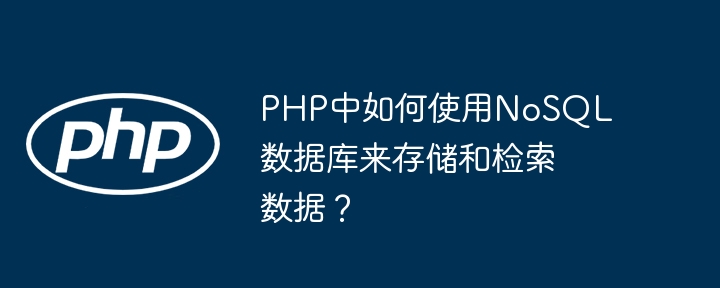Home >Backend Development >PHP Tutorial >How to use NoSQL database in PHP to store and retrieve data?
How to use NoSQL database in PHP to store and retrieve data?
- WBOYWBOYWBOYWBOYWBOYWBOYWBOYWBOYWBOYWBOYWBOYWBOYWBOriginal
- 2024-05-06 22:39:011081browse
Use NoSQL databases to store and retrieve data in PHP: PHP provides MongoDB, Redis, CouchDB and other libraries to interact with NoSQL databases. To use MongoDB to store data, you need to create a MongoDB client, select a database and collection, and insert data. Get the ID of the inserted data, find and iterate through the results to retrieve the data.

Storing and retrieving data using NoSQL databases in PHP
Introduction
NoSQL (non-relational) database is a flexible and scalable data storage model for storing and retrieving unstructured or semi-structured data. Unlike relational databases, NoSQL databases do not require data to be arranged in a predefined schema. This makes it ideal for storing large amounts of unstructured data such as documents, images, and videos.
Connect and operate NoSQL databases using PHP
PHP provides several libraries that can be used to interact with NoSQL databases. The following are the most commonly used libraries:
- MongoDB: a document-oriented database
- Redis: a key-value store database
- CouchDB: a document-oriented database, Emphasis on distributed features
Example: Using MongoDB to store and retrieve data
Let us use MongoDB to demonstrate how to store and retrieve data in PHP:
// 加载 MongoDB 库
require 'vendor/autoload.php';
// 创建 MongoDB 客户端对象
$client = new MongoDB\Client("mongodb://localhost:27017");
// 选择数据库
$db = $client->my_database;
// 选择集合
$collection = $db->my_collection;
// 插入数据
$result = $collection->insertOne([
'name' => 'John Doe',
'age' => 30
]);
// 获取插入数据的 ID
echo "Inserted document with ID: " . (string)$result->getInsertedId() . "\n";
// 查找数据
$cursor = $collection->find(['name' => 'John Doe']);
// 遍历结果
foreach ($cursor as $document) {
echo "Found document: " . json_encode($document) . "\n";
}Conclusion
You can easily connect and operate NoSQL databases by using the libraries provided in PHP. The flexibility of NoSQL databases makes them ideal for storing and retrieving unstructured or semi-structured data.
The above is the detailed content of How to use NoSQL database in PHP to store and retrieve data?. For more information, please follow other related articles on the PHP Chinese website!

